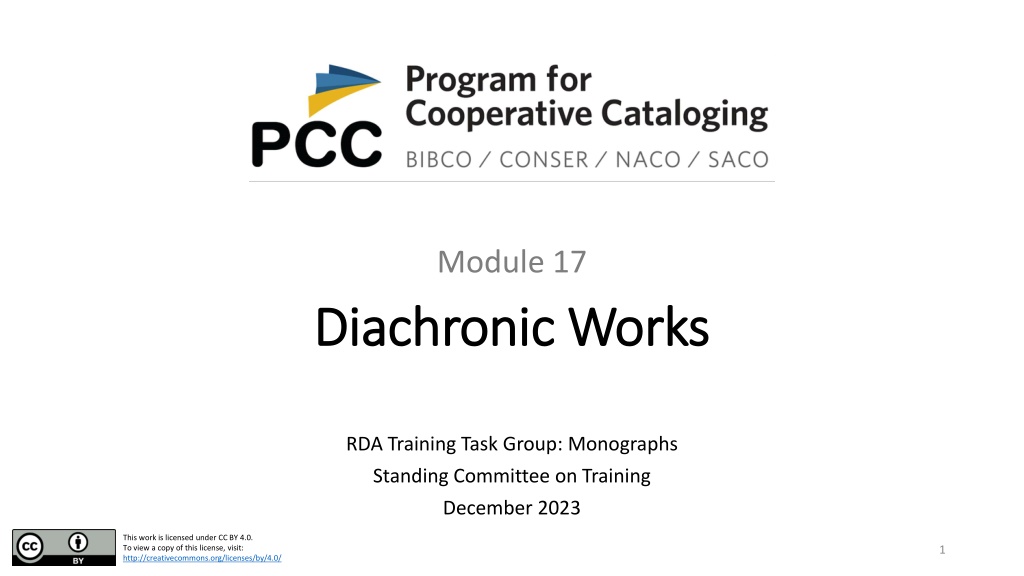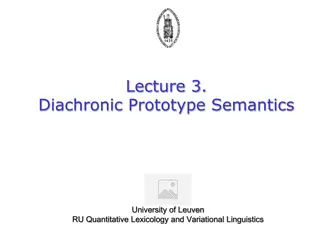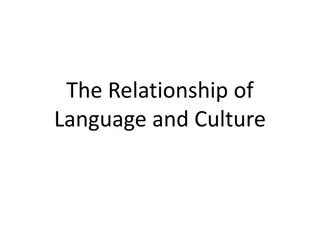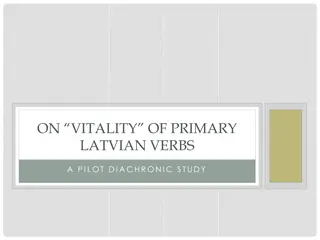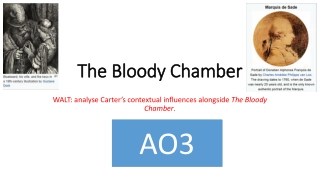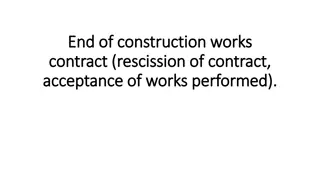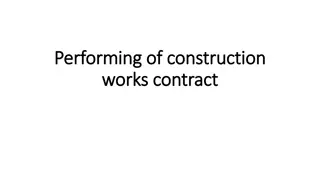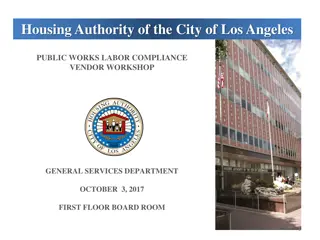Diachronic Works
The concept of diachronic works, learn to distinguish them from static works, understand extension plans, and recognize the significance of WEM lock in determining new works in this RDA training module.
Download Presentation

Please find below an Image/Link to download the presentation.
The content on the website is provided AS IS for your information and personal use only. It may not be sold, licensed, or shared on other websites without obtaining consent from the author. Download presentation by click this link. If you encounter any issues during the download, it is possible that the publisher has removed the file from their server.
E N D
Presentation Transcript
Module 17 Diachronic Works Diachronic Works RDA Training Task Group: Monographs Standing Committee on Training December 2023 This work is licensed under CC BY 4.0. To view a copy of this license, visit: http://creativecommons.org/licenses/by/4.0/ 1
Learning Outcomes At the end of this module, you will be able to: Distinguish diachronic works from static works Understand the importance of determining a work s extension plan Recognize the different types of diachronic works Recognize how the concept of WEM lock determines a new work 2
Outline What is a diachronic work? User-driven examples How diachronic works are different from static works Extension plans of diachronic works Concept of extension plans Special considerations in describing diachronic works The transformation boundary as an entity boundary WEM lock 3
Different kinds of works in RDA Diachronic work Static work 5
static work According to the RDA Glossary, a static work is a work that is planned to be embodied by a manifestation that results from a single act of publication or production. According to the Entity Boundary section on the Work entity page, a static work may be realized by two or more expressions that differ in content without changing the intellectual or artistic conception of the work. 6
User-driven example of a static work A high school student assigned to do a book talk on Harper Lee s To Kill a Mockingbird looks for a copy at the school library The library has multiple copies of To Kill a Mockingbird by different publishers = the library has copies of multiple manifestations of a static work The student borrows an available item = the student is interested in a static work 7
Screenshot from Merriam-Webster dictionary online, Diachronic, https://www.merriam-webster.com/dictionary/diachronic 8
diachronic work According to the RDA Glossary, a diachronic work is a work that is planned to be embodied over time. Where else can you find information about diachronic works? Guidance > Resource description > Describing a work Guidance > Diachronic works 9
diachronic work Guidance > Resource description > Describing a work A work may be planned to be embodied by a manifestation in a single act of publication or production or in a sequence of two or more such acts carried out at distinct intervals. The plan determines whether the content is fixed as a static work, or is changed over time as a diachronic work. A diachronic work may be planned to replace the content of a single expression or to accumulate the content by accumulating a sequence of expressions that are embodied at intervals of time. 10
User-driven examples of diachronic works A library user who visits their local library to browse issues of The New Yorker The library maintains a print subscription to The New Yorker = the library subscribes to a diachronic work The user comes into the library regularly to catch up on the latest available issues of The New Yorker = the user is interested in a diachronic work 11
User-driven examples of diachronic works A researcher comes into a British research library requesting access copies to all 31 serialized issues of A Tale of Two Cities https://commons.wikimedia.org/wiki/File:Cover_for_A_Tale_of_Two_Cities,_by_Phiz.jpeg The researcher wishes to examine how the cover art changed over the 31 weeks. = the researcher is interested in a diachronic work The library has all the issues = the library owns all parts of a diachronic work 12
User-driven examples of diachronic works A course instructor needs to provide student access to the official RDA Toolkit for an introductory cataloging course The course instructor works with the Faculty of Information to obtain a subscription to the Toolkit. = the school needs to subscribe to a diachronic work 13
User-driven examples of diachronic works A librarian who registered for the 2022 IFLA World Library and Information Congress is interested in seeing the most recent updates The librarian logs into the 2022 conference website = the librarian intends to browse a diachronic work 14
diachronic work Guidance > Diachronic works A work that is planned to be embodied over time, rather than in a single act of publication. The content of the work changes over time by being realized by one or more discrete expressions that are embodied by one or more manifestations. The essence of a diachronic work is a plan for the change of content. The element Work: extension plan is important to record. 15
diachronic work Guidance > Diachronic works A work that is planned to be embodied over time, rather than in a single act of publication. The content of the work changes over time by being realized by one or more discrete expressions that are embodied by one or more manifestations. The essence of a diachronic work is a plan for the change of content. The element Work: extension plan is important to record. Key idea: Plan for content that changes over time 16
Extension plans of diachronic works 18
1. Successive work (extension by accumulation) Passage of time 19
1. Successive work (extension by accumulation) Content is accumulated over time through a sequence of issues. Previous issues are retained as new issues are released. Each issue of the work is considered an expression that is embodied by a single manifestation. Each expression and manifestation of an issue of the work is also considered to be part of an overall expression and manifestation that realize and embody the successive work as a whole. Can be determinate or indeterminate. 20
2. Integrating work (extension by replacement) Passage of time 21
2. Integrating work (extension by replacement) Content is replaced at intervals Content from previous iterations is assumed to be inaccessible as it is gradually replaced Integrating work is realized in a single expression that is embodied by a single manifestation Can be determinate or indeterminate 22
Work: extension plan New attribute element to describe a work A categorization that reflects an intention to extend the content of a work. The plan for how the content will be updated over time 23
Extension plans and ONIX Guidance > Content and carrier > Extension plans The categories are derived from the RDA/ONIX framework for resource description. Screenshot from RDA/ONIX Framework for Resource Categorization, version 1.0. Released August 2006. Page A-3 Screenshot from RDA/ONIX Framework for Resource Categorization, version 1.0. Released August 2006. Page A-4 24
The Three Extension Factors 1. Extension requirement Static work: A work that is planned to be embodied in a single act of publication Diachronic work: A work that is planned to be embodied over time 2. Extension mode Integration: A diachronic work that uses replacement to extend the content Succession: A diachronic work that uses accumulation to extend the content 3. Extension termination Determinate: A diachronic work with a predetermined end for extending the content Indeterminate: A diachronic work without a predetermined end for extending the content 26
The Three Questions 1. Is the work planned to be extended or updated over time? No = Static work Yes = Diachronic work 2. Will the content be extended or updated by replacing existing content? Yes = Integration No = Succession 3. Is there a predetermined end for extending or updating the content? Yes = Determinate No = Indeterminate 27
RDA Extension Plan VES Static work = static plan Diachronic work + Succession + Indeterminate = successive indeterminate plan Diachronic work + Succession + Determinate = successive determinate plan Diachronic work + Integration + Indeterminate = integrating indeterminate plan Diachronic work + Integration + Determinate = integrating determinate plan 28
static plan According to the RDA Glossary, a static plan is: An extension plan for a work intended to be realized in one or more distinct expressions that are all embodied simultaneously. Includes poems, photographs, and completed novels. 29
static plan: example 1. Is the work planned to be extended or updated over time? No = Static work *extension plan = static plan 30
successive indeterminate plan: example 1. Is the work planned to be extended or updated over time? Yes = diachronic work 2. Will the content be extended or updated by replacing existing content? No = succession 3. Is there a predetermined end for extending or updating the content? No = indeterminate *extension plan = successive indeterminate plan 31
successive determinate plan: example 1. Is the work planned to be extended or updated over time? Yes = Diachronic work https://commons.wikimedia.org/wiki/File:Cover_for_A_Tale_of_Two_Cities,_by_Phiz.jpeg 2. Will the content be extended or updated by replacing existing content? No = Succession 3. Is there a predetermined end for extending or updating the content? Yes = Determinate *extension plan = successive determinate plan 32
integrating indeterminate plan: example 1. Is the work planned to be extended or updated over time? Yes = Diachronic work 2. Will the content be extended or updated by replacing existing content? Yes = Integrating 3. Is there a predetermined end for extending or updating the content? No = Indeterminate *extension plan = integrating indeterminate plan 33
integrating determinate plan: example 1. Is the work planned to be extended or updated over time? Yes = Diachronic work 2. Will the content be extended or updated by replacing existing content? Yes = Integrating 3. Is there a predetermined end for extending or updating the content? Yes = Determinate *extension plan = integrating determinate plan 34
Considerations in describing diachronic works 35
LC-PCC position on Work: extension plan LC/PCC practice: Do not record the element. The element will be evaluated for use at a future time. For instructions on applying the concept of an extension plan when determining entity boundaries, see the Metadata Guidance documentation. LC/PCC practice: See the Metadata Guidance documentation: Basic Cataloging Decisions. LC/PCC practice: See the Metadata Guidance documentation: Works. 36
Monographic series You may choose to catalog the monographic series as a diachronic work. You may choose to catalog each monograph in the series separately. What is the one-time work? How do you indicate the relationship to the diachronic work that is the monographic series? The monographs within the monographic series may or may not be numbered. 37
Monographs within a monographic series Choosing to catalog the monographic series as a diachronic work 38
Monographs within a monographic series Choosing to catalog each monograph in the series separately 39
Annuals with special themed issues Situation: You have an annual that releases new volumes each year. Each annual volume has a special theme and its own title. Cataloging treatment: You catalog the annual as a whole, rather than each volume separately. Do you bring attention to the individual volumes? If so, what are possible approaches? 40
Diachronic works as aggregating works A serial work is an example of both. The serial work is planned to be embodied over time. The content of the serial work changes over time with each unit that is issued. In RDA, each serial issue is itself a work, because each issue is a plan to bring together multiple expressions. When referring to the manifestation that embodies a specific issue, a unit is the Manifestation aspect Mode of issuance = multiple units, if in print 41
WEM Lock 42
Entity boundaries From Guidance > Entity boundaries: An RDA entity boundary is the set of criteria that is applied by an agent who creates metadata to determine if a description of a new RDA entity is required. From Guidance > Diachronic works: Transformation boundary = an entity boundary for a diachronic work. 43
Transformation boundaries Entity boundaries of diachronic works differ from those of static works A change in any of these aspects of a plan for the work = a transformation = a new work: Scope or editorial policy Genre or literary form Target audience Style Transformation boundaries apply ONLY to diachronic works 44
Transformation boundaries From Guidance > Diachronic works: Transformation boundaries: A change in the value of an element that is common to the parts, issues, or iterations of a diachronic work and their expressions and manifestations may indicate a change in the plan of a diachronic work. Examples: Two separate language expressions develop differently over time Two manifestations of the same expression may develop differently according to the possibilities associated with each carrier type 45
Transformation boundaries From Guidance > Diachronic works: Transformation boundaries: The actual change of content of a diachronic work cannot be predicted. For example, the content of two or more manifestations of the same expression of a diachronic work may diverge if the plan for one carrier type develops in a different way from the plan for another carrier type. This means that a diachronic work is realized by one and only one expression and embodied by one and only one manifestation. This is known as a WEM lock. 46
WEM lock is a transformation boundary A type of entity boundary involving a change in carrier type that changes the content and therefore signals the need to describe a new diachronic work A type of transformation boundary Applies only to diachronic works 47
WEM lock is a cardinality restriction Cardinality restriction: A diachronic work can only be realized by one expression and embodied by only one manifestation Implication: Print version of journal E-version of the same journal 48
WEM lock: a visual decoder Work Expression Manifestation 49
Print journal Print journal Successive work (extension by accumulation) Individual issue Individual issue Individual issue Article Article Article Article Article Article Article Article Article Article Article Article Passage of time 50
